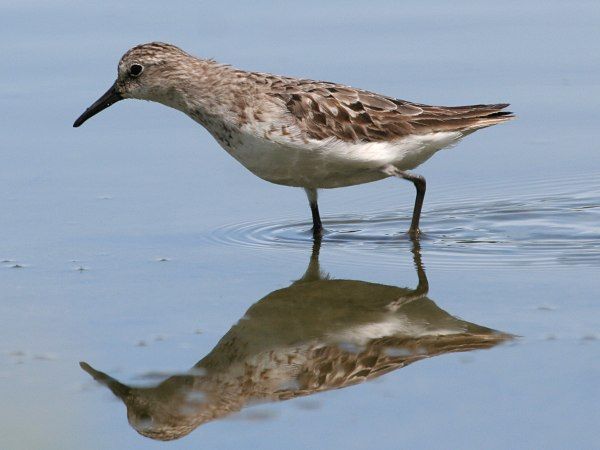Bigger-Brained Birds Keep Their Cool Under Pressure
Birds with high ratios of brain size to body size maintain lower levels of stress hormones in their blood compared to their less intellectual counterparts
/https://tf-cmsv2-smithsonianmag-media.s3.amazonaws.com/filer/20130911094152rsz_owl.jpg)
There’s a reason children taunt each other with calls of “Chicken!” at the smallest sign of hesitancy. Birds tend to be flighty little creatures, easily spooked at the first sign of danger. In nature–as reflected in pop culture–however, different birds deal with stress in a variety of ways. Diminutive Donald Duck is a mess of nerves, for example, whereas Big Bird is a chill, go-with-the-flow kind of guy.
In fact, in a curious case of art reflecting nature, it turns out a bird’s bird-brainedness is not a matter of personal bravado or cowardliness, but rather of a question of intrinsic smarts, a new study published in the Proceedings of the Royal Society B: Biological Science finds. The bigger the bird brain compared to the body, researchers discovered, the less ruffled that animal becomes under pressure.
When we encounter a stressful situation, whether bird or human, our body responds by flooding our system with stress hormones called glucocorticoids. For people, this fight-of-flight response may produce a racing heart and sweaty palms on the short-term, but if sustained over a long period of time–in the case of an illness in the family, a divorce or a job loss, for example–chronic stress can result in depression, insomnia and a host of other health impacts. Fellow vertebrates such as birds are no exception. How they cope with stress takes a toll on their ability to survive and produce offspring.
Not all species respond in the same ways to stress, however. Birds’ maximum stress hormone levels vary 12-fold across different species. Those species with the lowest stress levels, researchers hypothesized, may also possess the larger brains, which help them keep their feathers on when fear takes hold. Larger bird brains (pdf), past studies already found, correlate with a higher propensity for learning and for dealing with new situations. Evading as well as dealing effectively with problems requires some degree of smarts and the ability to learn, the researchers figured, so stress could be tied to a bird’s brain-to-body ratio–a proxy for intelligence.
To see whether bird brain sizes do indeed relate to their stress levels, an international team of researchers created a global database of stress levels reported in 189 previously published scientific studies for 119 bird species, from penguins to tropical songbirds. Stress levels in these studies were assessed by determining the concentrations of glucocorticoids in the birds’ blood.
Two different stress hormone levels–when birds were first captured and hadn’t had the chance to chemically panic yet, and when birds hit their peak stress levels after being held captive for 5 to 70 minutes–were included in the database. The authors used a statistical modeling technique to analyze the birds body-to-brain ratios compared to the animals’ glucocorticoids. They were careful to take into consideration how and when the stress level data had been attained, such as when the bird was migrating, wintering, preparing to breed or taking care of chicks.

Bird species, they found, share a common stress baseline and peak. In other words, all of Donal Duck’s brethren will be equally skittish, whereas Big Bird’s flock (yes, he has one) wil be relaxed all around. Further confirming their hypothesis, bigger-brained birds, they found, had lower levels of glucocorticoids in their blood than their less cranially-endowed counterparts.
Asio otus, the long-eared owl, for example, lived up to the wise owl stereotype with its large brain. It turned out to have relatively low stress hormone concentrations, as opposed to Calidris pusilla, the semipalmated sandpiper, which sat trembling at the other end of the small brain/high stress spectrum. During the wintering stage, the long-eared owl sported baseline stress levels four times smaller than the sandpiper.
When the owl was most stressed out, it was still relatively super-chill compared to sandpipers: the highest levels of stress hormone in the owl’s blood peaked at concentrations that were 3.5 times lower than peak stress levels found in sandpipers. Peak stress levels–when the avians were at the height of their frenzied freak-out–between these and other species were especially varied between the smart and not-so-bright birds.
Simply possessing a larger body size or living life at a slower pace, the team pointed out, did not necessarily mean a more relaxed outlook; in other words, a hummingbird would not necessarily be less adept at managing stress than an ostrich. Rather, the differences hinge upon that crucial brain-to-body ratio.
In addition to keeping their cool under pressure, the researchers predict that smarter birds likely know danger when they see it, and take measures to avoid it. More work will be needed to confirm this hypothesis, though it does hint at the possibility that, for birds at least, stupid-is-as-stupid-does, whereas the gift of intellect keeps perpetually giving.
/https://tf-cmsv2-smithsonianmag-media.s3.amazonaws.com/accounts/headshot/Rachel-Nuwer-240.jpg)
/https://tf-cmsv2-smithsonianmag-media.s3.amazonaws.com/accounts/headshot/Rachel-Nuwer-240.jpg)